Recent Posts
Restoring Your North St. Paul, MN Home After Fire Damage: How SERVPRO Can Help
10/19/2023 (Permalink)
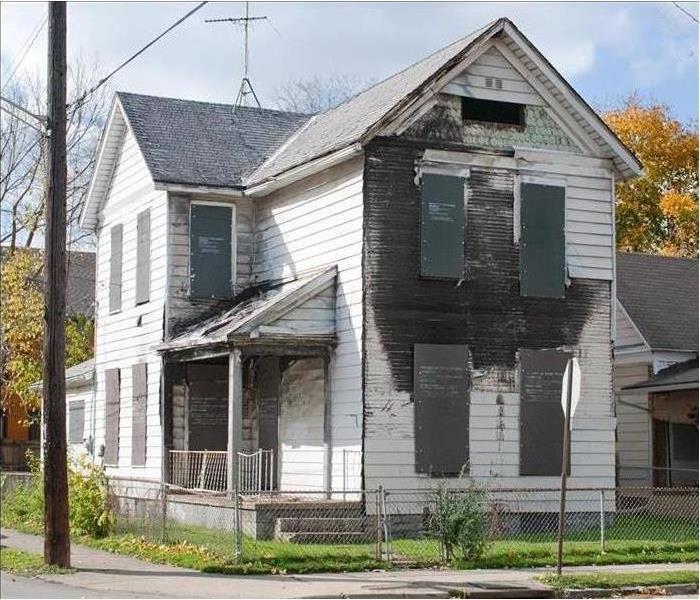 Fire damaged home in North St. Paul, MN.
Fire damaged home in North St. Paul, MN.
A house fire can be one of the most traumatic experiences a homeowner can endure. Not only does it pose a significant threat to life and property, but the aftermath can be equally devastating. In North St. Paul, Minnesota, where the winters are harsh, and the community is tight-knit, dealing with fire damage can be particularly challenging. However, there's hope, and that hope comes in the form of professional fire damage restoration services like SERVPRO.
In this blog, we will explore what steps to take after suffering fire damage in your North St. Paul home and how SERVPRO can assist in the restoration process.
3 Steps to Take After Suffering Fire Damage
Step 1: Ensure Safety
The first and most crucial step after a fire is to ensure your safety and the safety of your family. Evacuate the property immediately and call 911 if you haven't already. Firefighters in North St. Paul are skilled in handling such emergencies and will work diligently to extinguish the flames. Once the fire is out and the authorities give the green light, it's time to assess the damage and plan for restoration.
Step 2: Assess the Damage
After the fire has been extinguished and it's safe to return, assess the extent of the damage. Take photographs for insurance purposes, and make a detailed list of the damage to both the structure and your personal belongings. This information will be crucial when dealing with your insurance company. North St. Paul residents often rely on their homeowner's insurance to cover the costs of fire damage restoration, so being well-prepared can make the claims process smoother.
Step 3: Contact SERVPRO
One of the most significant steps you can take to restore your North St. Paul home after fire damage is to contact SERVPRO. SERVPRO is a nationwide leader in fire damage restoration, and they have a strong presence in Minnesota. Their professional team is experienced in handling the unique challenges presented by fire damage in a cold climate like North St. Paul.
How SERVPRO Can Help
1. Immediate Response
SERVPRO understands that fire damage is time-sensitive. The longer you wait, the more extensive the damage can become due to secondary issues like water damage, soot damage, and structural weakening. That's why they provide a 24/7 emergency response service. When you call SERVPRO, their technicians will arrive at your North St. Paul home promptly, ready to assess the situation and start the restoration process.
2. Comprehensive Cleanup and Restoration
SERVPRO offers a full range of services, from initial damage assessment to complete restoration. This includes:
Water Damage Restoration: After firefighting efforts, your home may have water damage from extinguishing the flames. SERVPRO uses advanced equipment to remove excess water and moisture and prevent further damage, such as mold growth.
Soot and Smoke Cleanup: The residue from a fire can spread throughout your home, causing extensive damage. SERVPRO uses specialized techniques and equipment to clean soot and smoke damage from surfaces, including HVAC systems.
Structural Repair: Fire can weaken the structural integrity of your home. SERVPRO can assess and repair structural damage to ensure your home is safe and sound.
Content Cleaning: Your personal belongings, if not completely destroyed by the fire, may be affected by smoke and soot. SERVPRO offers content cleaning and restoration services to salvage as much as possible.
3. Odor Removal
One of the most challenging aspects of fire damage is the lingering odor. SERVPRO uses advanced deodorization techniques to remove these unpleasant odors, leaving your North St. Paul home smelling fresh and clean.
4. Working with Insurance
SERVPRO can work directly with your insurance company to streamline the claims process. They understand the complexities of insurance policies and can provide documentation and information to support your claim. This can significantly reduce the stress of dealing with insurance during an already difficult time.
5. Certified Technicians
SERVPRO's technicians are certified and trained to handle fire damage restoration. They stay up-to-date with the latest techniques and equipment, ensuring the highest level of service for North St. Paul residents.
Suffering fire damage in your North St. Paul home is a devastating experience, but it's essential to know that you're not alone. Professional restoration services like SERVPRO are dedicated to helping you recover and rebuild. Their experienced team, prompt response, and comprehensive services can make a significant difference in the restoration process, ensuring your home is once again a safe and comfortable place to live. Don't hesitate to reach out to them if you find yourself in the unfortunate situation of dealing with fire damage in North St. Paul. They're ready to help you on your journey to recovery and restoration.
Top 5 Places for Mold Growth in Your Home
9/11/2023 (Permalink)
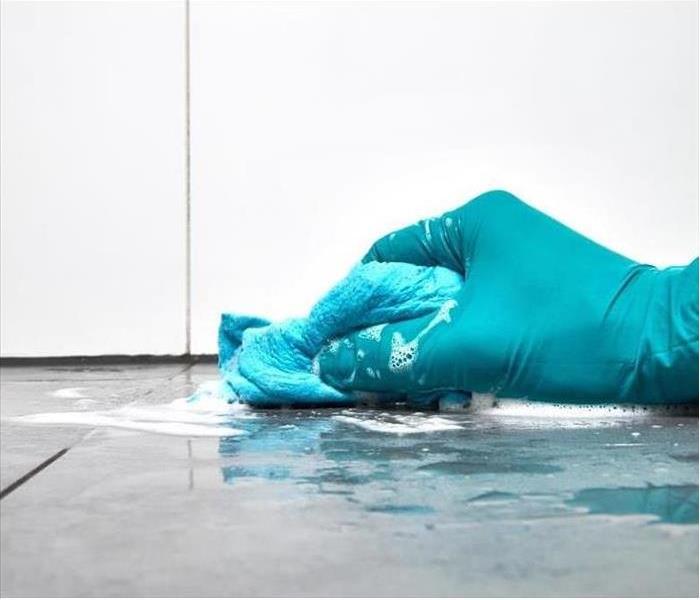 Avoid mold growth in your North St. Paul, MN home.
Avoid mold growth in your North St. Paul, MN home.
Unfortunately, mold is an uninvited guest in many households in White Bear Lake, MN. Mold growth can happen in various places around the home, although some areas are more common than others for this unwanted substance.
Conditions for Mold Growth
Mold thrives in certain conditions. Without them, it is hard for it to grow and spread. Mold prefers areas that have:
- Water or moisture
- Warmth
- Oxygen
- Darkness
- Food
Mold feeds not only on food items such as meat, fruit and vegetables. It also gets food from household materials. You may find mold on wood or wet carpet, or moldy drywall in a damp basement.
What areas around the home are the most common for mold? Here are the top places you can find it.
- Bathrooms
Your bathroom is perhaps the wettest room in your house. Between the tub, toilet and sink, mold has an abundant water source in this room. Add in the warmth and humidity from steamy showers and wet towels, and you have a breeding ground for mold.
Clean your bathroom frequently to discourage mold from growing. Pay special attention to tile grout and caulk. Wash shower curtains and bath mats often. Don't leave wet towels bunched up on the floor.
- Kitchens
The sink, refrigerator and dishwasher are water sources for mold in the kitchen. It can feed on old food in the refrigerator, trash can or cabinets. It can collect on unwashed dishes. It can even find a home on clean, damp dishes stored in a dark cupboard.
To combat mold in the kitchen, wash damp rags and towels frequently. Throw away old food. Check under the cabinets and behind appliances for leaks.
- Laundry Rooms
A leaky washing machine and damp clothes can give mold a place to grow. Take care not to leave wet clothing piled around the laundry room. Check hoses regularly for leaks.
- Basements and Attics
The basement and attic in your home are typically dark, undisturbed areas. They can easily collect water from leaky vents or walls. They can also build up condensation if not properly vented. You may need to make an effort to inspect these areas if you don't use them regularly. Check for leaks and mold. If you see large growth areas, you can call a professional restoration service to have it removed.
- Bedrooms
While you might not have a direct water source in the bedroom, leaking windows or ceilings can introduce moisture into this room. An old mattress or pillow can also harbor mold. They can collect moisture from humidity and sweat, and mold can feed on the porous material inside.
It isn't too hard to inhibit mold in the bedroom. Watch for moisture around windows and ceilings. Encase your mattress in a protective cover or choose one that is mold-resistant. You can also air out your bed and rotate the mattress frequently. Replace old pillows and enclose new ones in a protective case.
Mold growth is no fun to deal with. Preventing it from appearing in the first place is your best mold-fighting strategy. If you check for leaks around your home and clean high-moisture areas frequently, you should be able to keep your White Bear Lake, MN, house in good shape.
Bursting Pipes 101: Act Right Away and Call in Experts
8/31/2023 (Permalink)
 Hire a professional team to clean after a flood to avoid water damage in your White Bear Lake, MN property.
Hire a professional team to clean after a flood to avoid water damage in your White Bear Lake, MN property.
After the initial rush of water from bursting pipes, you're left with soaking carpets, water-logged floors and walls, and a lot of situations that could cause lasting trouble for your White Bear Lake, MN, property. At this point, it is vital that you contact water damage cleaning professionals to mitigate ongoing damage.
The Destructive Nature of Water From Bursting Pipes
Water is both essential and problematic. You probably couldn't continue daily operations without a clean, steady supply of it. However, once that water bursts out of pipes and spreads throughout your buildings, a lot of destruction takes place and happens rapidly:
- Wet carpets and padding
- Stained furnishings
- Soaked fabrics
- Spread of contaminants
Unfortunately, this damage is just the beginning of the trouble you could face. Secondary damage happens after the bulk of the mess has been cleared away:
- Mold and mildew growth
- Wood rot and decay
- Corrosion of metal structures and wiring
- Weakened structures
Even a small area of trapped moisture can cause your drywall to rot or paint to peel. After a water emergency, your property must be completely cleaned and dried to prevent secondary damage.
Your Quick Response Matters
The action you take in the first few minutes of the bursting pipes has long-term effects on the welfare of your property. First, locate the source of the leak, so you can fix the broken pipe and shut off the water, either at the closest water shut-off valve or at the building's water main. At this point, it is also important to turn off the electricity to all exposed areas of the property. It only takes a little bit of water and electricity to pose an electrocution risk.
With these steps complete, gather as many hands as possible to soak up, mop, and remove water. Open doors and windows to allow for plenty of airflows and to let building humidity escape from buildings. If it is safe to use electricity, install powerful fans to dry the air and speed the rate of evaporation.
Remove water-logged furnishings to clean, sunny places outside or remove them to dry areas of your property. At this point, it is important to determine the role of professionals.
Professional Services Save Money
There are many factors that influence how well you can respond to water damage on your own. These include how fast you can remove water on your own, how susceptible your belongings are to water damage, and whether water is contaminated. Professionals generally have more people available to handle the work quickly. Valuable belongings, such as antiques, paperwork, carpeting and drapery, and appliances, require an expert response to prevent further damage. When you call in water damage cleanup and mitigation experts, you could save time, reduce the extent of the destruction, avoid cross-contamination, prevent mold growth, and steer clear of making mistakes, such as damaging electronics that haven't been appropriately cleaned and dried.
Prevent long-term secondary damage by the understanding of the destruction that bursting pipes can cause, the importance of your immediate response, and the expertise provided by professionals. The more you know, the better you can protect your property.
Steps You Can Take To Improve Your Kids' Safety During a Home Fire
8/31/2023 (Permalink)
 Follow These Tips To Improve Your Kids' Safety During a Home Fire in your North St. Paul, MN property.
Follow These Tips To Improve Your Kids' Safety During a Home Fire in your North St. Paul, MN property.
Imagining your home and family being threatened by fire can be scary, but when you and your children are prepared for this scenario, you'll all feel a little more confident. Your children may have participated in fire drills at school in North St. Paul, MN, now it's time for them to run through these drills at home as well. Regular practice is crucial for your kids safety.
Focus on Kids Safety
During Fires According to the National Fire Protection Association, it only takes a minute or two for fire to spread through your home and prevent safe evacuation. However, there are several things you can do to improve your chances:
- Install fire alarms in each bedroom, hallway, and floor of the home.
- Close bedroom doors while sleeping.
- Create fire escape plans and practice them regularly.
- Teach and practice fire safety with your children.
Install Fire Alarms
There are two types of smoke detectors, and experts recommend that you have both or a device that combines both types of technology. Once you’ve installed an appropriate number of alarms, make sure you replace batteries once or twice a year, keep them clean and free of debris, and know when to replace the alarms.
Close Bedroom Doors
According to firefighters, roughly half of residential fires happen while the family is asleep. The good news is that closed doors reduce smoke damage, slow the spread of the fire, and help family members stay safe. During a fire, the closed bedroom door helps keep the room's temperature below 100 degrees Fahrenheit, improves oxygen levels in the room, and reduces the level of carbon monoxide.
Create and Practice a Fire Escape Plan
Your fire escape plan should have tips for helping children who can't escape on their own, a meeting place outside of the home, and multiple paths of escape. Work with family members to pinpoint multiple routes of evacuation, including windows. Teach children to leave the home immediately, not even stopping to call 911, gather belongings, or look for other family members.
Reach out to your local fire department for more education and child-based resources. It isn't uncommon for children to feel frightened at the sight of firefighters, so the more familiar they are with the uniforms, tools, and sounds, the better.
Teach and Practice Fire Safety
The U.S. Fire Administration also provides resources you can use to teach your children basic fire safety and what to do during a home fire. These lessons must include ways to prevent fire, and you must also teach your children vital steps, such as checking for heat, smoke, and flames before opening doors, where to stay if they cannot get out of their rooms, and what to do if their clothes catch on fire. Your kids' safety improves with each home fire drill and teaching session you practice.
In the Event of a Fire …
Even with plenty of fire prevention and kids safety steps, your home may still be affected by a fire. When this happens, fire damage cleanup and repair professionals can help with the reconstruction efforts while you focus on the well-being of your family members.
The more you can do before a fire, the better prepared you and your children will be for getting through the experience safely.
How To Properly Snake a Clogged Pipe
8/18/2023 (Permalink)
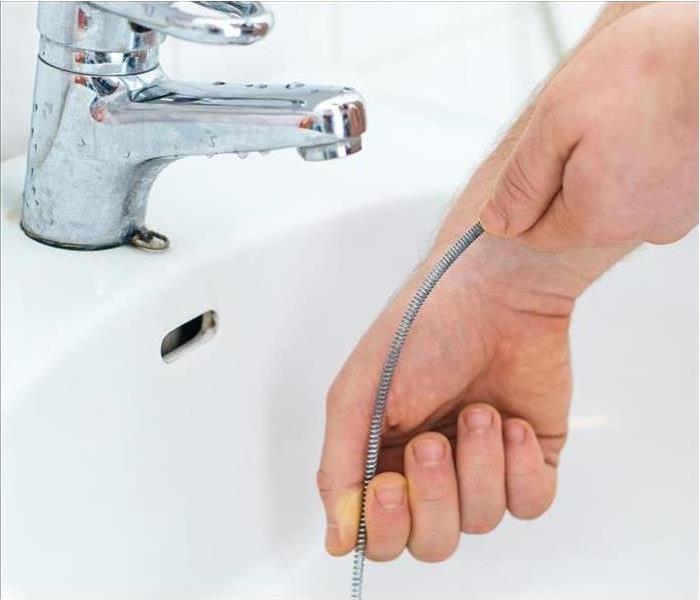 Use a plumbing snake to unclog the drain in your White Bear Lake, MN, home.
Use a plumbing snake to unclog the drain in your White Bear Lake, MN, home.
Whenever you have a clogged toilet or drain, plunging is usually the first thing you do to try to break up the clog. However, when plunging doesn't work, many people resort to chemical drain openers. Because these chemicals can damage your plumbing, it is better to first try clearing the clog with a plumbing snake.
How To Unclog a Drain or Toilet With a Plumbing Snake
Using a plumbing snake is not particularly complicated, but there are a few guidelines you should follow. If you don't already have a plumbing snake, you can purchase one from most hardware or home improvement stores.
- Insert the Snake Into the Drain or Toilet
If you are dealing with a stopped toilet, you can insert the snake, which looks like a long thin wire with a coil on the end, into the opening in the toilet bowl. For sink or tub drains, insert it directly into the drain. If the snake won't fit through the drain cover, you may have to remove the cover or purchase a smaller snake.
- Push the Snake Into the Drain Until You Feel Resistance
If you are using a manual snake, you will need to turn the handle to feed the snake into the drain. You may need to apply pressure to get past curved areas. If you are using an electric model, follow the operating instructions.
- Rotate the Snake Until the Resistance Goes Away
Once you have reached the clogged area, rotate the snake to break up the clog. Once the clog is broken up, the snake should slide easily into the rest of the drain. However, if you don't seem to be making any progress, try pulling the snake out of the drain. If the head has embedded or entangled the material in the clog, it may pull the clog out with it.
- Run the Water or Flush the Toilet
To make sure your drain is fully unclogged, run the water for a few minutes or flush the toilet a couple of times. If everything seems to be working properly, then you are probably done. If you still have a clogging problem, then repeat the process. If after trying again, you still have an issue, you may have a pipe break or other serious plumbing issue that needs professional attention. Call a plumber in White Bear Lake, MN, to assist you.
- Clean Up Any Water
Water from an overflowing toilet, sink, or tub can damage your home and lead to mold growth if not dried out quickly. You can remove small amounts of water with a wet/dry vacuum or a mop and bucket. However, large amounts of water or water that may contain contaminants may be better handled by a professional water remediation company. Try to completely dry out your home within 24 to 48 hours. After this amount of time, mold growth may become a problem.
There are many options for tackling a clogged toilet or drain. It is best to start with the methods that involve the least expense and potential for property damage, rather than jumping straight to calling a plumber or using potentially harmful chemicals.
7 Tips for Removing Odors From Flood Water
8/18/2023 (Permalink)
 Avoid lingering smells cause by water damage in North St. Paul, MN.
Avoid lingering smells cause by water damage in North St. Paul, MN.
Water damage can leave behind unpleasant odors caused by mold growth and bacteria. These tips can help you get rid of them.
Removing Odors Caused by Flood Water
Water can severely damage your home and contents in a variety of ways. One of those ways is by leaving behind unpleasant smells due to bacteria from sewage loss or mold growth. Fortunately, there are steps you can take to eliminate odors.
- Identify What Is Causing the Odor
If mold is the problem, then you have to remove the mold to get rid of the odor. If something else is causing the smell, then you can try cleaning and deodorizing to get rid of it.
- Dry Out Your Property Quickly
The most effective way to avoid mold odors is to prevent mold from becoming a problem in the first place. Mold can begin to grow in 24 to 48 hours after water damage occurs. The faster you can dry out your property, the less likely you are to have problems. Consider contacting a flood remediation company in North St. Paul, MN, to help you speed up the process.
- Remove Damaged Items
Removing water-damaged furniture, carpets, drywall and other materials can help you avoid a mold problem. Place these items outside to dry, if the weather permits. Removing this source of moisture will help you get your property dried out faster.
- Remove Mold
If you discover mold, you need to remove it to get rid of the smell. Inspect the damp places in your home where mold may be present. For areas smaller than 10 square feet, you may be able to clean up the problem by scrubbing surfaces with household detergent and water. Avoid using bleach. Bleach may kill mold, but will not kill mold spores and your attempt to clean the area may cause the spores to spread throughout your home. For larger areas, consider contacting a mold remediation company to assist you.
- Use Baking Soda on Carpets
When your carpet is dry, sprinkle baking soda on it and let it sit overnight. Use a vacuum to remove the baking soda. If you still have odors, try removing the carpet pad. Carpet pads usually can not be saved after water damage.
- Apply White Vinegar to Upholstery
Use a spray bottle filled with white vinegar to spray vinegar on your upholstered furniture. Allow the vinegar to air dry. Once the vinegar has dried, the odor from the vinegar and the water damage should be gone.
- Remove the Source of the Odor
If your water damage is the result of an ongoing problem, such as sewage backup or leaking pipes, repair whatever is causing the damage before you try to clean up odors. If you don't fix the problem, then the odors will probably keep coming back.
Lingering smells from mold growth or other problems caused by water damage can be a frustrating problem, particularly if you have already put in a lot of work to repair your property. However, there are steps you can take to get rid of bad smells and prevent them from coming back.
6 Smoke Odor Remediation Tips
9/15/2022 (Permalink)
 If your home has fire damage, exist some tips to remediate the odor.
If your home has fire damage, exist some tips to remediate the odor.
Whether it's cigarette smoke, burnt food, or damage from a house fire, smoke odors are notoriously difficult to get rid of. These six tips can help you in your smoke cleaning efforts.
- Let Some Fresh Air in
If you are dealing with a lingering smoke odor, open your windows and doors. Place fans with the blades blowing outward in the largest windows. This will help remove smoky air from your home. Leave the fans running for 24 hours if you can. Remove smoky books, furniture, clothing, and other items from your home and place them outside in a sunny area for several hours. The UV rays from the sun can neutralize odors. However, sunlight can also damage some items, so delicate belongings may need to be moved to the shade.
- Clean With Vinegar
White vinegar can be a useful smoke cleaning tool. The low pH of vinegar alters the higher pH of smoke molecules, which reduces the potency of their smell. Fill some small bowls with white vinegar and place them in the area you are trying to clean. Let them sit overnight. You can also boil a pot of vinegar on the stove and then allow it to simmer for an hour or two. Clothing that smells like smoke can be washed in your washing machine with a half cup of white vinegar, instead of laundry detergent.
- Try Baking Soda
Baking soda is useful for absorbing a variety of odors, including smoke smells. You can use the same technique as with the vinegar by placing baking soda in small bowls and leaving the bowls in the area you are cleaning for 24 hours. You can also sprinkle a thin layer of baking soda onto upholstered furniture, carpets, and rugs. Leave it overnight and then vacuum. Baking soda can also be useful for cleaning books and other small items. Pour a half cup of baking soda into a plastic trash bag and then add the smoky items. Tie the bag shut and leave it overnight.
- Use Some Charcoal
The carbon molecules in charcoal are useful for trapping odors and removing them from the air. Activated charcoal works best. Place several bags of charcoal in the smoky area and leave it overnight. Make sure it stays in the bags because the charcoal can leave stains if it comes in direct contact with surfaces.
- Try Steam Cleaning
Steam cleaning can be useful for floors, walls, and upholstery. The heat melts the tar and oils that trap smoke molecules, allowing you to wipe them away with a sponge or cloth. Mist affected surfaces lightly with steam and then wipe the steam away.
- Call a Restoration Company
If do-it-yourself methods are not effective or you have a large amount of smoke damage, consider contacting a fire restoration company in North Saint Paul, MN. These companies have professional training and equipment and can often remove stubborn odors that may be beyond the reach of do-it-yourself remedies.
Lingering smoke odors can seriously degrade your enjoyment of your home and possessions. Fortunately, there are methods of smoke cleaning that can effectively remove these odors.
4 Steps To Resolving Water In a Light Fixture
9/15/2022 (Permalink)
 Water in light fixtures is not uncommon.
Water in light fixtures is not uncommon.
While finding water in light fixtures may be a weird site, it is not uncommon, especially in multiple-story homes. However, it is not safe to leave water dripping into fixtures, so it is essential to resolve the problem quickly by contacting water mitigation professionals in White Bear Lake, MN.
Here Are 4 Steps To Resolve Water In a Light Fixture
- Shut off the breaker
- Call a specialist
- Resolve the issue
- Restore the property
1. Shut Off the Breaker
Before you concern yourself with ceiling damage, shut off the breaker to the affected light fixture. Water and electricity do not mix, and if left unattended can cause significant safety risks. Your breaker panel is likely found in your home's mechanical closet or basement.
2. Call a Specialist
After you shut off the breaker for the affected fixture, you can address the water in the light. However, you may want to call in a water mitigation company to assess the problem. Your house likely has a leak above the light fixture, and you will not know how bad the leak is until someone inspects the area thoroughly.
3. Resolve the Issue
When the mitigation crew arrives, they will inspect the area and offer an estimate for their services. Once you agree to the terms, the team will disassemble the light fixture and cut access holes into the ceiling. They will find the underlying leak and resolve the problem.
4. Restore the Property
After fixing the leak, the mitigation company will restore your property. They will patch any holes and replace all insulation and drywall affected by the leak. Finally, they will replace the light fixture and make sure that everything works as intended.
Almost no one expects to find water in light fixtures in their home, but it does happen. If you happen upon this type of damage, then turn off the electricity and contact a mitigation company for help. After all, there is no need to risk your safety.
Tips for Cleaning Items After a Flood
8/17/2022 (Permalink)
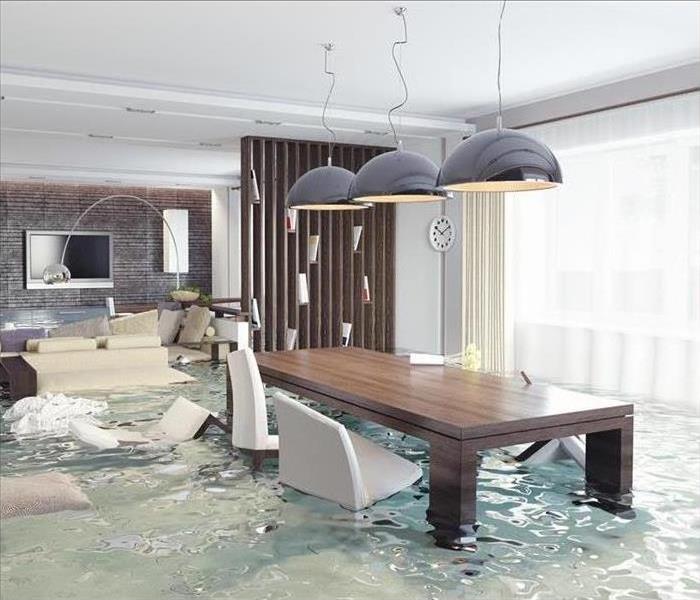 Hire professionals to deal with flood damage.
Hire professionals to deal with flood damage.
A heavy storm or busted pipe can leave a lot of water in your home in White Bear Lake, MN. Flooding not only affects the structure itself but also many of the items in the house. Before you throw everything away, it's worth trying to see what you can salvage.
3 Tips to Cleanup Items After a Flood
1. Dry Items
Files, photo albums and certificates that are drenched from a broken pipe may seem like a total loss. It may be possible to save them, though. The key to doing so is often to remove as much of the water as possible. You don't want to harm the items, so it's important to let them air dry. Avoid rushing the process with excess heat or light sources:
- Sunlight
- Oven
- Hair dryer
- Iron
You may be surprised how many items make it through the flood without secondary damage just fine as long as you allow them to dry gently.
2. Remove Dirt
Excess water in your home often brings extra grime along with it. Sturdy items can usually be rinsed with clean water to flush away some of the debris. If your furniture or curtains have dried, you may be able to brush away the residual dirt with a coarse-haired brush. Getting the worst of the dirt off can help make the mitigation process go more smoothly.
3. Hire Professionals
The most important thing you can do after a flood is rely on the expertise of flood remediation specialists. These technicians can help you determine which items to keep and which to discard. They also employ various methods such as dry cleaning and gamma radiation to restore your treasures.
Just because you have a lot of water in your home, that doesn't mean you have to lose everything. You can probably salvage even some of the more fragile family heirlooms with the right care and help. Consult your remediation experts before you throw anything away.
Can I Save My Commercial Property After Water Damage?
7/31/2022 (Permalink)
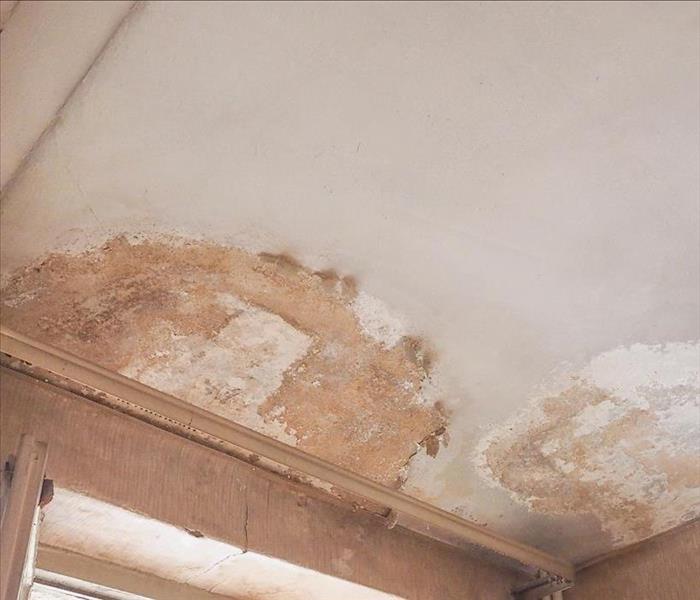 Water damage in St. Paul, MN.
Water damage in St. Paul, MN.
Unfortunately, some type of water damage is always possible at your Saint Paul, MN, commercial building, no matter where it's located. From bad weather to a leaking pipe to a sewer backup, it's helpful to know what to do in a water disaster. Even a little moisture left to linger can become a significant loss. Therefore, it's essential to mitigate the damage as quickly as possible upon discovering the flood.
Water Cleanup and Restoration Tips for Your Commercial Property
1. Protect Yourself
Safety is the first factor to consider when dealing with a flood. It's essential to shut off the electricity before anyone goes into the affected area. If you can't safely navigate to the breaker box, call an electrician or the electric company to shut it off before you make another move because an electrical current could be flowing through the water. Depending on the type of flood you have on your hands, you may need to consider wearing personal protective equipment (e.g., safety glasses, facemask, rubber gloves) to clean.
2. Eliminate the Standing Water
Once the area is safe to enter, the best option, if you have it, is using a wet/dry vacuum. This is typically the safest and most efficient way to extract standing water. If you don't have a wet/dry vac accessible, grab a mop, bucket, and some towels.
3. Clear the Area
Next, it's time to clear out the affected area as much as possible. This will give you more room to clean, find the extent of damage, sort through your contents, and allow for more airflow for drying. If the outdoors is less humid than indoors, you can place the contents outside to begin drying in the fresh air and sun.
4. Inspect for Damage
Hiring water damage restoration professionals to perform a thorough inspection and remediation can be very beneficial. They have the expertise and equipment to ensure the building is returned to its pre-flood condition.
5. Determine What Is Salvageable
Sort through your property to determine what is salvageable and what isn't. Many of the porous materials will probably be ruined. However, professionals can sometimes use special techniques to restore these items, even books and photos.
6. Dispose of the Unsalvageable
If you've had standing water on hardwood, laminate or carpeted flooring, it probably won't be salvageable as it won't be possible to dry them quick enough to prevent significant damage, such as warping, buckling and mold growth. Some parts of your drywall will likely have to be cut out and replaced because drywall is porous and can soak water up like a sponge.
7. Clean and Sanitize Everything Thoroughly
Everything must be cleaned and sanitized thoroughly, especially if the flood results from broken pipes like sewer lines and contains harmful bacteria or other toxic substances. You will need to clean every surface that the water has touched.
8. Dry Everything Thoroughly
Finally, everything must be dried completely within 24 hours of its exposure to water. You can use fresh air, dehumidifiers, fans and heaters to help the process.
Water damage can take over immediately and do increasingly more damage every minute that passes. Fortunately, there are ways to prepare so you can start water cleanup immediately should the worst occur.

 24/7 Emergency Service
24/7 Emergency Service









